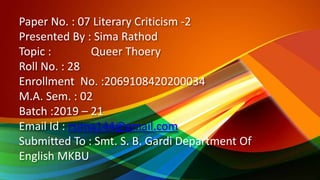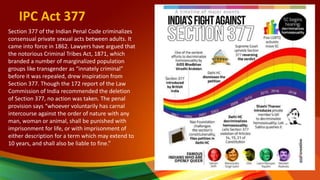Queer Theory literary criticism -2
- 1. Paper No. : 07 Literary Criticism -2 Presented By : Sima Rathod Topic : Queer Thoery Roll No. : 28 Enrollment No. :2069108420200034 M.A. Sem. : 02 Batch :2019 ¨C 21 Email Id : rsima144@gmail.com Submitted To : Smt. S. B. Gardi Department Of English MKBU
- 2. What is Queer Theory? Queer theory is a field of critical theory that emerged in the early 1990s out of the fields of queer studies and women's studies. Queer theory includes both queer readings of texts and the theorization of 'queerness' itself. Heavily influenced by the work of Lauren Berlant, Leo Bersani, Judith Butler, Lee Edelman, Jack Halberstam, and Eve Kosofsky Sedgwick, queer theory builds both upon feminist challenges to the idea that gender is part of the essential self and upon gay/lesbian studies' close examination of the socially constructed nature of sexual acts and identities.
- 3. IPC Act 377 Section 377 of the Indian Penal Code criminalizes consensual private sexual acts between adults. It came into force in 1862. Lawyers have argued that the notorious Criminal Tribes Act, 1871, which branded a number of marginalized population groups like transgender as ¡°innately criminal¡± before it was repealed, drew inspiration from Section 377. Though the 172 report of the Law Commission of India recommended the deletion of Section 377, no action was taken. The penal provision says ¡°whoever voluntarily has carnal intercourse against the order of nature with any man, woman or animal, shall be punished with imprisonment for life, or with imprisonment of either description for a term which may extend to 10 years, and shall also be liable to fine.¡±
- 4. Continue¡ In 2009, the Delhi High Court read down Section 377 to apply only to non- consensual, penile, non-vaginal sex, and sexual acts by adults with minors. In December 2013, a two-judge Bench of the Supreme Court, on appeals filed by private parties, set aside the High Court¡¯s judgment. It upheld the criminalization of gay sex while virtually denying the LGBTQ community the right to sexuality, sexual orientation and choice of partner. In July 2018, a Constitution Bench, led by Chief Justice Dipak Misra, re-opened the entire issue, saying a section of people could not live in fear of the law which atrophied their rights to choice, privacy and dignity.
- 5. Homosexuality in Ancient India ? In the temples of Khajuraho, there are images of women erotically embracing other women and men displaying their genitals to each other. Scholars have generally explained this as an acknowledgement that people engaged in homosexual acts. ? In the Valmiki Ramayana, Lord Rama's devotee and companion Hanuman is said to have seen Rakshasa women kissing and embracing other women. ? At another place, the Ramayana tells the tale of a king named Dilip, who had two wives. He died without leaving an heir. The story says that Lord Shiva appeared in the dreams of the widowed queens and told them that if they made love to each other, they would have a child. The queens did as ordained by Lord Shiva and one of them got pregnant. They gave birth to a child, who went on to become famous king Bhagirath, best known for "having brought River Ganga from heaven to the earth".
- 6. Continue.. ? The Mahabharata has an interesting story about Shikhandini, the feminine or transgender warrior of the time and responsible for the defeat and killing of Bhishma. Shikhandini was a daughter of King Drupada, who raised her as a prince to take revenge from the Kurus, the rulers of Hastinapur. Drupada even got Shikhandini married to a woman. After her wife discovered the reality, she revolted. The day was saved by divine intervention bestowing Shikhandini with manhood during night. Shikhandini henceforth lived like a hermaphrodite. ? Another scripture, the Narada Purana has references to what may be classified as "unnatural offences" described in Section 377. At one place, the Narada Purana states, anyone who discharges semen in non-vaginas, in those beings destitute of vulva, and uteruses of animals is a great sinner and will fall in hell. The purana does not approve of "unnatural offences" but the references prove that they were in practice. ? Ancient Indian texts, inscriptions and paintings on temple walls, clearly, don't approve of homosexuality, but the repeated references do acknowledge its existence in those days.
- 9. So What ? ? Homosexuality is not a crime , its ¡° Natural¡± ? It¡¯s ok if a boy loves a boy or a girl loves a girl, it¡¯s NOT a ¡°CRIME¡±. ? Proper education is must for the acceptance of Homosexuality.
- 10. Works Cited India Today. 10 July 2018. 26 February 2020 <https://www.indiatoday.in/india/story/10-instances-of- homosexuality-among-lgbts-in-ancient-india-1281446-2018-07-10>. Krishnadas, Rajagopal. The Hindu. 21 July 2018. 26 February 2020 <https://www.thehindu.com/news/national/what-is-section-377-and-why-does-it- matter/article24483691.ece>.
Editor's Notes
- #2: This template is provided by http://www.free-power-point-templates.com/









